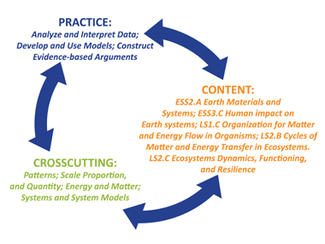Science
6-8 Science Guides & Resources
- A Framework for K-12 Science Education: Practices, Crosscutting Concepts, & Core Ideas
- Jefferson Middle School's Next Generation Science Standards (NGSS) Webpage
Key Conceptual Shifts in the Next Generation Science Standards
1. K-12 Science Education Should Reflect the Interconnected Nature of Science as it is Practiced and Experienced in the Real World. The framework is designed to help realize a vision in the sciences and engineering in which students actively engage in scientific and engineering practices and apply crosscutting concepts to deepen understanding of core ideas in these fields. Students must be engaged at the nexus of the 3 dimensions:
1. Science and Engineering Practices,
2. Crosscutting Concepts, and
3. Disciplinary Core Ideas.
2. The Next Generation Science Standards are student performance expectations – NOT curriculum. Each performance expectation Science and Engineering Practices (SEP) are partnered with a particular Disciplinary Core Idea (DCI) and Crosscutting Concept (CC) in the NGSS. These intersections do not predetermine how the three are linked in curriculum, units, or lessons. Performance expectations simply clarify what students will know and be able to do.
3. The Science Concepts in the NGSS Build Coherently from K–12. The focus on a few Disciplinary Core Ideas is a key aspect of a coherent science education with a basic set of core ideas meant to be understood by the time a student completes high school.
4. The NGSS Focus on Deeper Understanding of Content as well as Application of Content. Understanding the core ideas and engaging in the scientific and engineering practices helps to prepare students for broader understanding, and deeper levels of scientific and engineering investigation, later on—in high school, college, and beyond.
5. Science and Engineering are Integrated in the NGSS, from K–12. A significant difference in the Next Generation Science Standards (NGSS) is the integration of engineering and technology into the structure of science education. The rationale for this difference rests on two positions, aspirational and practical:
- Aspirational standpoint - Science and engineering are needed to address major world challenges and solving problems of global environmental change that confront society today.
- Practical standpoint - Engineering and technology provide opportunities for students to deepen their understanding of science by applying their developing scientific knowledge to the solution of practical problems.
6. The NGSS are designed to prepare students for college, career, and citizenship. All students no matter what their future education and career path must have a solid K–12 science education in order to be prepared for college, careers, and citizenship.
7. The NGSS and Common Core State Standards (English Language Arts and Mathematics) are Aligned. The timing of the release of NGSS comes as most states are implementing the Common Core State Standards (CCSS) in English Language Arts and Mathematics. See Venn Diagram Below This is important to science for a variety of reasons: (1.) An opportunity for science to be part of a child’s comprehensive education. (2.) NGSS are aligned with the CCSS to ensure a symbiotic pace of learning in all content areas. and (3.) The 3 sets of standards overlap in meaningful and substantive ways and offer an opportunity to give all students equitable access to learning standards.

NGSS Overview
Introduction to the Next Generation Science Standards
The Next Generation Science Standards (NGSS) are K–12 science content standards. Standards set the expectations for what students should know and be able to do. The NGSS were developed by states to improve science education for all students.
SCIENCE AND ENGINEERING PRACTICES Science and Engineering Practices describe what scientists do to investigate the natural world and what engineers do to design and build systems. The practices better explain and extend what is meant by “inquiry” in science and the range of cognitive, social, and physical practices that it requires. Students engage in practices to build, deepen, and apply their knowledge of core ideas and crosscutting concepts.
DISCIPLINARY CORE IDEAS Disciplinary Core Ideas (DCIs) are the key ideas in science that have broad importance within or across multiple science or engineering disciplines. These core ideas build on each other as students progress through grade levels and are grouped into the following four domains: Physical Science, Life Science, Earth and Space Science, and Engineering.

NGSS Disciplinary Ideas
Disciplinary ideas are grouped in four domains:

